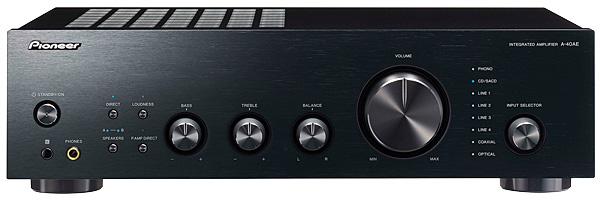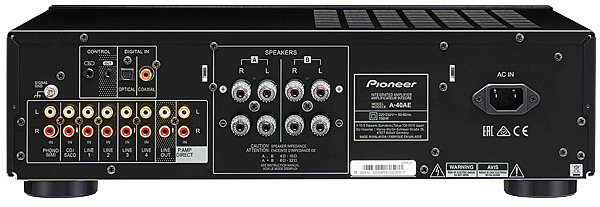Pioneer A-40AE integrated amplifier/DAC

 Inspired by the success of its A-70 integrated from 2012, Pioneer has trickled down the tech and combined it with a new close-coupled PSU in this DAC-equipped budget amp
Inspired by the success of its A-70 integrated from 2012, Pioneer has trickled down the tech and combined it with a new close-coupled PSU in this DAC-equipped budget amp
Having recently achieved the grand old age of 80 years, the Pioneer Corporation is rightly celebrating the fact. While some believe that all Japanese companies are the same – faceless consumer electronics giants with sprawling factories full of robots, making generic white goods – anyone who's lived in Japan knows this couldn't be further from the truth. In practice, each organisation has its distinct identity and corporate culture, going about things in its own special way.
Some lead where others follow, and Pioneer is a prime example of this, having played a pre-eminent role in the development of sound and vision [see Sidebar]. Without this venerable Japanese giant, it's fair to speculate that the specialist hi-fi and home theatre worlds might have been quite different.
Pioneer's Party
As the champagne corks pop, Pioneer has been launching a brand new range of electronics, the mainstay of which is a line of integrated amplifiers that includes the £400 A-40AE reviewed here. Is this the product to put the company back on the two-channel hi-fi map?
Said to have been designed with sound quality uppermost, it comes in a sleek box, with plenty of power and a wide range of inputs. Indeed, you could almost think of it as a 21st century Pioneer A-400 [HFN Sep '90]. This, as readers of a certain age might remember, offered a similar combination of functionality and performance some 30 or so years ago. As US baseball star Yogi Berra once said, it's like 'déjà vu, all over again'.
Of course, the new A-40AE isn't a simple carbon copy of its best-selling antecedent – rather you could say it's a case of 'traditional values in a modern setting'. Designed to appeal to seasoned audiophiles and newcomers alike, it offers a claimed 2x76W/4ohm, among other figures [see PM's Lab Report]. This is similar to the old A-400, which wasn't prodigious in its power, but had just enough to tickle the cones of the less efficient standmounts of that era. Another key facet of the A-400 was its unexpectedly wide range of inputs – all analogue back then, but it did include phono and two tape loops. The new A-40AE has five line inputs, plus MM phono and two digital inputs (optical and coaxial). Owners of three-head tape recorders have, however, been rather cruelly overlooked.

A fixed line output – or what would have been called a 'record out' in the old days – is fitted here to feed external headphone amps, among other things. Disappointingly, however, there is no preamp output, but there's a 'Power Amp Direct' facility, switched on the front panel, that lets you bypass the A-40AE's preamplifier section/volume control and allows the internal power amp to be fed directly from the (variable) output of a DAC, for example.
Take The Direct Route
Two pairs of loudspeakers can be switched from the front panel, a feature the old A-400 lacked. The rear-panel loudspeaker binding posts are chunky affairs that take both 4mm banana plugs and bare wire. Should you choose to use the A-40AE as a normal integrated amp, you'll find there are bass and treble controls fitted, along with balance and a 'Direct' switch to bypass all of these, should you so wish. And I'd certainly recommend that you do, for my auditioning confirmed the results of PM's lab tests, proving the Direct switch, in this amp at least, is a valuable function that really lifts the sound.
Moreover, Pioneer has laid out its brushed aluminium fascia panel in a neat, clean way and the pressed steel casing is of decent quality for the price. Naturally it comes in a choice of black and silver finishes, the former still accounting for the lion's share of production. The alloy volume control knob has a pleasingly silky action compared to some amps at this price, and also like the legacy A-400, there's a full size headphone socket on the front panel.
Under the A-40AE's bonnet, Pioneer uses custom ELNA capacitors in the PSU section and makes much of its 'Direct Energy Power Supply'. While not quite as grandiose as the term suggests (Pioneer uses close-coupled PCBs, rather than wires, between the PSU and power transistors), the idea is to get more power to the business end of the amplifier more directly, which is surely no bad thing.
![]() Pushing The Boundaries
Pushing The Boundaries
If you think that £400 will very likely buy you a pretty crude and thin-sounding amplifier, with little in the way of charm or emotional pull, then the A-40AE will more likely prove a breath of fresh air. While not exactly setting the world alight, Pioneer's A-40AE still serves up an enjoyable and engaging sound that is satisfying enough to listen to over long periods. Its sins are those of omission, because it doesn't add anything nasty to the sound. It's clear that Pioneer has done a top job on a tight budget and ended up with a good, useable device that's largely vice-free.

























































